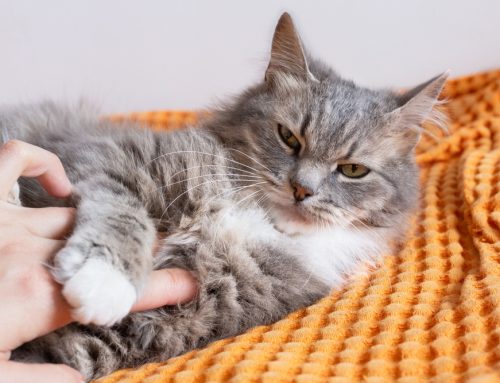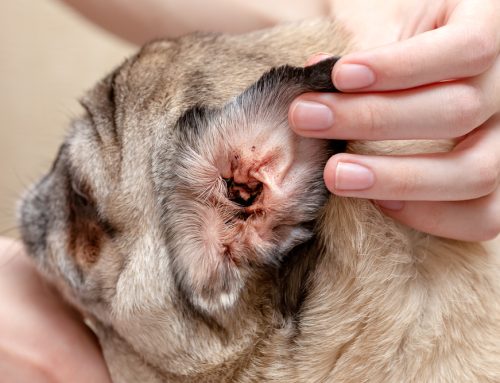In honor of National Pet Dental Health Month, our Countryside Veterinary Hospital team wants you to know what really happens inside your pet’s mouth. Rather than a behind-the-scenes look, we are taking you on a “through the mouth” adventure, so you can see exactly what we look for when we evaluate your furry pal’s dental health. Follow along as we examine the mouth of one of our patients—a sassy tortoiseshell named Diamond.
Diamond’s oral health exam
As Diamond the tortie entered our hospital, we could hear her yowls of displeasure clear to the back of the building. Diamond is no fan of car rides and is always reluctant to enter her carrier at home, and equally reluctant to leave when she arrives at our hospital. Over many years of caring for Diamond, however, we have learned what makes her tick—and how to keep her and our team safe during an exam.
We immediately ushered Diamond and her owner into an exam room, and removed the top of her carrier to let her explore at her own pace, but Diamond refused to prowl around and hunkered down into the bottom of her carrier. Regardless, we still spent time talking to Diamond’s owner, Mrs. Ring, about the problem she had noticed before we moved toward the wary cat.
“Lately, Diamond has not been grooming herself, and I’ve noticed a lot of drool. I thought drooling was a dog thing, but she has been leaving wet spots everywhere she lies. She’s also become extremely picky about her food. I’ve always fed her the best kibble and pâté, but now she turns her nose up at the dry food, and licks only the juice off the pâté. Please help my beautiful girl, Dr. Conley,” Mrs. Ring requested.
“Hmm. Her mouth may be bothering her, Mrs. Ring. I’ll do my best to look inside her mouth when we do her regular physical exam,” Dr. Conley said.
Our team prepared to handle Diamond by spritzing a fleece blanket with Feliway, a calming feline pheromone spray, and opening a tube of chicken Churu, a tempting lickable purée. Moving slowly, we wrapped Diamond in the blanket, leaving only her head poking out, and tried to entice her with the special treat, but Diamond refused to be bribed, and hissed when we tried to examine her mouth. Fortunately, we were able to quickly glance into her wide-open mouth and we could see that her gums were severely inflamed, and looked almost brick-red.
“It looks like Diamond has severe gingivitis, or gum inflammation, throughout her entire mouth,” Dr. Conley said. “While I could not see a great deal of tartar accumulation on her teeth, the level of gingivitis worries me. I’d like to conduct a comprehensive oral health assessment while Diamond is under anesthesia. This ensures she won’t feel any discomfort or anxiety as I examine her mouth, and our team will be able to clean her teeth at the same time,” she said.
After Mrs. Ring gave her consent, Diamond was anesthetized and Dr. Conley began her oral exam, probing around each tooth, checking out her tongue and palate, and examining all her oral structures and tissues. She found holes in the enamel of several teeth, and a fractured tooth. Because the nerve was exposed in the teeth, Diamond’s pain and refusal to eat dry food was no surprise.
Next, we took a full set of dental X-rays, which helped identify Diamond’s problems hidden below the gum line. Dr. Conley noticed some tooth-root fragments under the gum line where we had marked a missing tooth. Based on the X-rays, we determined that Diamond’s tooth had become so diseased that the crown broke off, leaving the roots behind. With all this information, Dr. Conley diagnosed Diamond with resorptive disease, in which the immune system attacks the tooth enamel and erodes the protective coating until the sensitive pulp is exposed.
The best treatment for teeth affected by resorptive lesions is extraction. Untreated, a resorptive lesion will continue to invade the tooth, causing more pain as more of the nerve is exposed. This disease can affect the tooth structure both above and below the gum line, so total extraction rather than a crown amputation is necessary. To help alleviate Diamond’s pain, Dr. Conley extracted the diseased teeth, and removed the hidden root fragments. Her veterinary technician finished Diamond’s oral procedure by cleaning and polishing her teeth.

As Diamond was discharged, we instructed Mrs. Ring to let her cat’s mouth heal from the extractions, and to offer only soft food for the next week. After Diamond recovered, we told Mrs. Ring, she needed to introduce toothbrushing, because brushing Diamond’s teeth daily would minimize plaque and tartar accumulation, and reduce the potential for resorptive lesions. A low oral bacterial load helps prevent dental and resorptive disease, since the bacteria are a major trigger for immune system overdrive and an attack on the teeth. Plus, a low oral bacteria population prevents spread to the heart, liver, and kidneys, which is especially important for older cats susceptible to kidney disease.
To further prevent pain and more resorptive lesions, we scheduled Diamond for dental cleanings every six months. This would help keep her mouth healthy, and would allow our team to spot and treat early stage lesions, before Diamond suffered.
While Diamond’s case sounds severe, resorptive disease is relatively common in cats, and also affects dogs. But, staying on top of your pet’s dental health through daily toothbrushing, regular oral exams, and frequent dental cleanings can prevent such serious problems. Remember, because you do not see a large amount of tartar on your pet’s teeth does not mean that disease is not lurking below the gum line. Contact our Countryside Veterinary Hospital team to schedule an oral exam to assess your pet’s dental health.








Leave A Comment